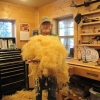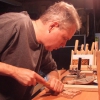This might sound a bit 'philosophic', but it's extremely important to understand that your woodcarving effectively follows the decisions of your mind, conscious or unconscious.
When you realize this, you'll see the need for a mental preparation before you start: to pause and consider; to feel where you are going. If you don't do this, if you don't know what wood you need to carve away, you may well end up down the wrong path.
In this lesson we'll do a bit of this 'mental preparation' before we begin bosting, getting our principal forms. We'll look at references in the model that will help us, how we migh hold the woodcarving and so on.
Depth gouge: I refer to a special depth gauge in this lesson. You can see it here.

| 06 November 2013 14:18
Eric - I get asked about all sorts of wood and I'm afraid my experience lags well behind. As a rule, however, you want to find as tight and uniform a grain structure as possible. I know Western Red Cedar is used by Native American carvers so there's a good chance you can use it for some types of work. The best thing to do of course, for any new wood, is find a piece and try it out!

| 06 November 2013 04:01
Chris, I know you have not carved much in Western Red Cedar, but do you see any reason why I should not try this in clear grain cedar? It is rather easy to obtain here in the US Pacific Northwest. Seems like cedar would take the detail you need here.

| 06 November 2013 03:59
Ah, that scary moment, when "it's time to start" and at some point, I have to put the chisel to wood. So profound in the video... Chris just "does it"! How long have I looked at the wood and Chris' videos before I put the chisel to the wood!

| 21 October 2013 17:02
It's like having the magician show how the trick is done...but coming away with an even greater appreciation for the trick rather than coming away disillusioned!
..and I am only three videos in. :-)
Thank you Chris.